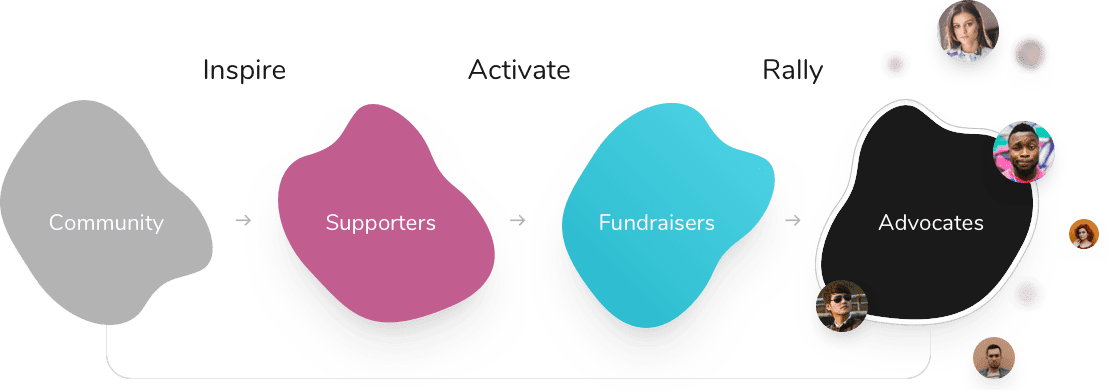A new fundraising playbook for today’s online economy.
It’s about time we rethink how we fundraise.
Times have changed.
Technology has revolutionized the way we live our lives. Nowadays, we’re spending more and more of our waking hours staring at screens. With unlimited data plans and apps for everything, most of our daily activities are conducted online.
In many ways, technology has improved the quality of life, including bringing about the unprecedented growth of e-commerce, automation, and knowledge at our fingertips.
While on the one hand technological innovations have made things more convenient, the growth of a digital-first generation can be a bit overwhelming and the way that nonprofits fundraise hasn’t always kept up.
Donor behavior has changed, and we see this through statistics:
- In the last 2 years, there’s been a 24% growth in online donations.
- In 2018, mobile giving increased by 205%.
- 65+% of all fundraising site web traffic is on mobile, and is growing each year.
- 54% of consumers have used a mobile wallet to make a donation.
- 52% of millennials are interested in monthly giving as a meaningful way to give back.
- 68% of donors agree that knowing how their donation makes an impact is important to their gift.
- Supporters are 70% more likely to give again if they gave on a branded page the first time.
- Donors are 400% more likely to give again if they’re thanked within the first 48 hours.
With these shifts towards digital fundraising, and specifically toward mobile, your donors are telling you they’re looking for a deeper relationship with your organization, frequent communication, and an easy digital giving experience.

Many folks are still stuck in traditional, “project-style” fundraising (sending direct mailers a couple times a year, hosting an annual gala/event, writing grants, etc.). This leaves many nonprofits stuck: locking themselves into only fundraising at specific times.
Because of the technological shift, “project-style” fundraising approaches don’t always translate when applied to raising funds online.
This stop-start style of fundraising often leaves fundraisers feeling stuck and frustrated, always spinning their wheels, and not being able to sustainably grow their fundraising, because while this project-based fundraising may have worked well before, donor’s preferences have changed.
Instead, we believe that traditional methods should go hand in hand with ones with a digital focus.
You can adapt your fundraising approach to fit your donor’s needs, and develop an ongoing, sustainable process to grow your fundraising.
At CauseVox, we believe in a “process-oriented” approach towards fundraising. This is digital fundraising in a nutshell. We believe that the best online fundraisers are digital marketers and vice versa.
Digital fundraising involves using your supporters’ voices to help elevate your cause. By taking a “process-oriented” approach and leveraging peer networks, digital fundraising builds a sustainable fundraising model towards individual gifts.
There are three main stages to the digital fundraising process. Enter, the Digital Fundraising Cycle:
Attract
Get the attention of your prospective donors with strategies like SEO, digital ads, and more, leading your audience to engage with you.
Nurture
Target your engaged potential donors (or current donors) with content to educate and inspire your supporter to take action. You’ll want to employ strategies like email nurturing campaigns, social media posts, and storytelling-driven and impact oriented content.
Convert
Get your potential supporter to complete a donation by making a strong ask across multiple channels and give your donors an easy giving experience on any device.
Repeat
Now that you have acquired a new donor, it’s time to continue to attract them to your cause, nurture them with information and storytelling, and convert them again so they continue to donate to your organization.
In this way, the Digital Fundraising Cycle helps you create a process that allows you to develop predictable and sustainable growth at your organization while meeting your donor’s needs.
Chances are, you’re already digitally fundraising without even knowing. If you’ve ever shared a social media post or asked for donations in honor of your birthday, you’ve dabbled in digital fundraising. But by being intentional and paying particular attention to the three stages (Awaness, Nurture, and Convert), digital fundraising is a game changing strategy that will help your organization thrive.

Why Use Digital Fundraising?
The basics of fundraising have always been the same - attracting, nurturing, and converting donors is nothing new. But, exactly how organizations have done has evolved dramatically over the years.
Pre-1950
Birth of Modern Fundraising
1950-2005
Mass Fundraising
2006-2017
Internet Fundraising
Nonprofits and charities have always relied on word-of-mouth referrals to boost their donor base. However, these interactions were usually in-person or over the phone and were personalized, specific asks. Most often, a prospective donor would only be considered if someone believed they would have an interest in the cause.
Nonprofits first began developing fundraising plans and campaigns in the early 1900s. Much of fundraising was reliant on relationships with personalized, specific asks (typically targeting wealthy donors). Modern practices like short-term fundraising campaigns and fundraising thermometers developed, paving the way for the future.
Over time, organizations began using advertising via direct mail, the phone, telethons, and eventually television commercials to spread the word. But this resulted in a ton of messages, most of which went unread and unanswered. This blanket marketing got organizations in front of people but didn’t include much “buy-in” factor.
This just rented donor’s attention– and it didn’t work at converting and developing relationships with nonprofit’s audiences.
The internet revolution has connected us all in unimaginable ways. With the rise of the internet, the key learnings from this blanket style advertising carried over to all online channels.
But the internet is different. With audiences constantly engaged on social media, text, email, and more – we’re developing deep relationships through the internet, instead of the one-way communication of Mass Fundraising. With increased connectivity, there’s an audience of eager listeners out there who want and expect to hear from the things they’re engaged with – including nonprofit organizations.
This desire for connection is why digital fundraising matters. The method, when used with each touchpoint and incorporated into regular fundraising activities throughout the year, builds on your supporter’s relationship with you and then converts it into natural word-of-mouth marketing.
With digital fundraising, your donor’s value isn’t tied to a donation amount— it’s the passion they convey to others that determines their lifetime worth.
Today, digital fundraising comes in many forms, including peer-to-peer fundraising, online crowdfunding campaign, social sharing of your campaigns or messages, or interactive online and offline fundraisers, and special events.
What Are The Benefits Of Digital Fundraising?
Digital fundraising isn’t just a trending strategy among nonprofit fundraising professionals – it’s the present and future state of fundraising, and the key to your fundraising growth.
When planned for and executed properly, digital fundraising has immediate and long-term benefits for your organization.
Predictable Donations
Retention
Digital fundraising lends itself to long-term predictable and sustainable growth. By investing in digital marketing (SEO strategies, ads, etc.), you’re able to build brand awareness and cultivate a broad support base. Over time, as these individuals are cycled through the digital fundraising loop (attract, nurture, and convert), conversion trends will start to emerge, which will let you know what is and isn’t working. This data will also help inform how you invest your time and optimize for growth moving forward.
Streamline Workflow
Less Overhead
Digital fundraising is ultimately all about making it easy for you and your donors.
No one wants to give on a clunky page that doesn’t work on their phone. Similarly, no organization wants to spend hundreds of hours manually sending receipts and dealing with messy reporting.
Digital fundraising well means streamlining your processes with tech that helps you fundraising well, both saving you time and delighting your donors. Improve Communications
Digital fundraising helps you make data-driven decisions for optimal fundraising results. You’ll be able to figure out which fundraising strategies work and which don’t, based on a wealth of insights to inform your future fundraising strategy.
You can use this data to learn what motivates your donors to give, segment and improve the way you communicate with your donors, and ultimately, hone in on areas to focus your efforts to optimize for donor conversions.
Raise More
Acquisition
There’s no denying that fundraising is based on relationships and connections. When you effectively attract, nurture, and convert donors well, you’re building a relationship that lasts. Not only are you increasing each donor’s lifetime value with digital fundraising, ultimately, you’ll inspire your supporters to become advocates. And when your strongest supporters share your organization with their friends and family, those networks are inclined to listen.
Digital fundraising helps you raise more by organically connecting you with your audience — widening and deepening it at the same time.
The Many Variations of Digital Fundraising
Digital fundraising differs from traditional fundraising strategy because it involves mobilizing your supporters into action to help your nonprofit or charity raise friends and ultimately, funds. Thankfully, there are a whole host of ways to mobilize your supporters.
Events & Campaigns
Race, walks and runs Event-driven peer-to-peer Annual funds Crowdfunding
Giving Days & Project
GivingTuesday and other giving days Virtual events Capital projects Program campagins
A digital campaign is great for events that require registration (galas, races, walks, etc.) because you can easily see how many people have signed up at a glance. Moreover, a digital fundraising campaign for your event makes it more inclusive and extends your reach to people who can’t make it to the live event but would still like to donate.
For special giving days such as #GivingTuesday, a digital fundraising campaign is the way to go. In addition to short-term or one-day campaigns, you can also set up a digital fundraising campaign for annual campaigns (i.e. board giving) or to fund capital projects like building improvements.
Peer-to-Peer
& DIY
Third-party events Memorials and tributes Challenges, weddings and birthday campaigns
Personal
Campaign
Personal crowdfunding cause-based fundraising
With peer-to-peer and DIY digital fundraisers, anyone can set up on their own page to start raising money for your cause. The key ingredient to DIY is the social factor; your supporters are relying on their friends and families to help them, help you. From dedicating birthdays to hosting a polar plunge challenge, digital fundraising can be applied to a number of peer-to-peer/DIY ideas.
Along with the growth of Digital Fundraising has been the growth of recurring giving. When you prompt donors to give monthly on your donation form or in a recurring-driven fundraising campaign, you’re setting yourself up to have predictable and sustainable income at your organization. With a 90% donor retention rate, you can use recurring giving to lay a solid foundation for your organization to grow your digital fundraising.
Digital Fundraising Methodology
There are three core elements of digital fundraising: Attract, Nurture, and Convert. Incorporating this framework can help you drive growth and cultivate deeper relationships with your supporters.

Attract
In order to get people’s attention, you want to do things that make a lot of noise. And let’s face it, there’s already a lot of noise.
Attract is basically nonprofit digital marketing 101. It’s a strategy to generate interest in your organization that eventually paves way for a call to action or provides ways for your supporters to keep in touch. Luckily, there’s several ways to attract a supporter base through digital marketing. You’ve got:
- Earned media, which is free publicity through third-party promotional efforts. Earned media is cost-effective because it doesn’t require you to use your own budget. Instead, you’re leveraging the credibility of existing supporters and advocates to reach a broader audience.
- Paid media through sponsored blog posts, online ads, commercials, and more to promote your cause. Paid content allows you to track your reach through measurable insights and even target specific segments of the population.
- Owned media is any digital property you control or operate. The most common example is your organization’s website but owned media also includes any social media pages/accounts which are extensions of your brand.

Nurture
More often than not, someone is giving to your cause because they feel emotionally connected to some degree. To do this, you’ll nurture existing relationships or start building rapport with the audience you’ve attracted.
Connecting with your supporters usually starts with a story. “Nurture” is basically email marketing campaigns, storytelling, and other initiatives that are dual parts educational and relatable. The story can take many forms, such as written word, an image, or video. Although nonprofit stories come in many forms, each has similar key elements, including introducing a problem and a solution provided by your organization.
At CauseVox, we highly encourage our customers to use nonprofit storytelling whenever and wherever possible because it helps build trust and loyalty. Whether it’s through written word, an image, or a video, it’s always a good idea to remind others as to why they should get involved with your cause.

Convert
The conversion stage of the process involves getting your supporter to complete a donation. This looks like making a strong donation ask through email, social media, your website, and any other fundraising tools you may be using.
Now that you’ve taken your supporter on a journey, and they’re ready to become a donor, an important part of the conversion process is doing just that: making sure your donors convert.
Donors today are expecting a donation process that’s on par with their other online activity- it should be quick and easy to donate on any device they prefer.
A good donation experience shows your donors that you care about their time, effort, and funds.
When you give donors a good experience, they’re more likely to convert and give again in the future.





